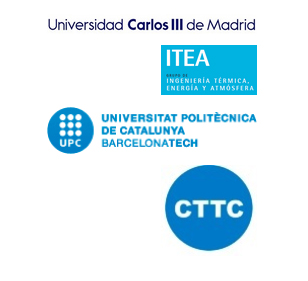Humidity Optimization Tool (Clean Sky - 7th European Framework Programme)
- Grupos de investigación
- Ingeniería
- Ingeniería Térmica, Energía y Atmósfera (ITEA)
- Humidity Optimization Tool (Clean Sky - 7th European Framework Programme)
Funding

European Research Council - H2020 - Clean Sky
Partners

Background and objectives
State of the art
The general need of a comfortable atmosphere composition implies that a broad range of devices have to deal with humid air. These devices range from complex ECS (Environmental Control Systems) at aircrafts, to almost any air breathing dispositive, including engines.
The condensation of vapour into liquid water is a relevant issue for many of their processes, especially if expansions are included.
Their modelling includes the evaluation of “humid air” as the limit of complexity for standard engineering.
This evaluation provides the amount of liquid water produced in the device but does not solve important issues. Generally, it does not predict if the water generated produces settled liquid water or a fog. In case both kinds are present, it does not indicate the ratio between the amount of liquid water laden in the flow and the one wetting the walls. Also the size and number of water droplets at the fog is rarely solved.
This issues, together with the visual effect of a given fog when it is mixing with an ambient are characteristics to unveil in the research field, up to present time.
Objectives
The general purpose of the project is to develop a tool able to predict generation and evolution of water fogs in the ECSs, in order to deal with them with the minimum energy cost.
The particular objectives are:
1) Determination of a fog visibility criterion
2) Development of a 0D tool to predict the size and number of the water droplets downstream a: (i) Pack outlet turbine (ii) Post-turbine Heat exchanger, and (iii) Mix-manifold
3) Development of a tool to predict fog visibility along the plume of outlets of these fogs into ambient conditions.
4) Validation of these tools
Only regarding aircraft ECSs, the amount of kerosene directly consumed worldwide is in the order of 3 million tons per year. Just an improvement of 1% on their performance, based on a better process knowledge, would save every year 10 million Euro and a 100.000 tons of CO2. Despite these are a small proportion of the possible target devices, it justifies the cost of this project in just 10 days.